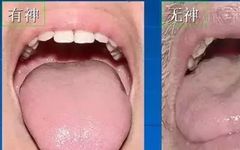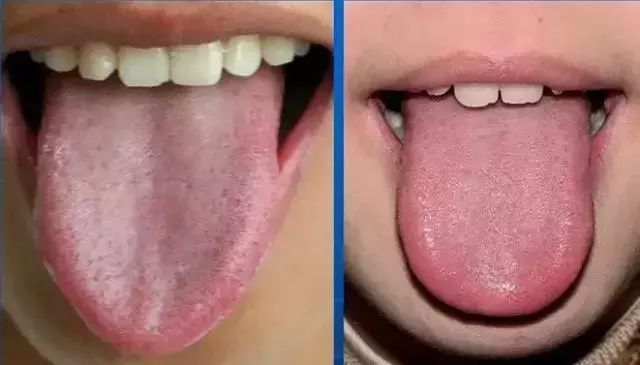
Observing Tongue Quality
The tongue quality, also known as the tongue body, refers to the muscle and vascular tissue of the tongue. Observing the tongue body mainly involves examining the tongue spirit, tongue color, tongue shape, tongue state, and the sublingual vessels.
1. Tongue Spirit
(1) With Spirit (Glorious Tongue)
【Tongue Characteristics】 The tongue color is red, vibrant, and moist, with agile movement.
【Clinical Significance】 A glorious tongue indicates a good prognosis, even in illness.
【Mechanism Analysis】 A glorious tongue primarily reflects sufficient body fluids, abundant qi and blood, and a strong spirit. The “Guide to Tongue Observation: Differentiating Tongue Spirit and Qi” states: “If the tongue quality is bright and substantial, regardless of yellow, white, gray, or black, scraping reveals a red and moist interior, and the spirit is flourishing, all diseases are auspicious.”
(2) Without Spirit (Dry Tongue)
【Tongue Characteristics】 The tongue color is dry, dull, lifeless, and lacks vitality, with impaired movement.
【Clinical Significance】 A dry tongue indicates a poor prognosis.
【Mechanism Analysis】 A dry tongue primarily reflects a deficiency of body fluids, severe qi and blood depletion, and a weakened spirit. The “Guide to Tongue Observation: Differentiating Tongue Spirit and Qi” states: “If the tongue quality is dull and lifeless, regardless of whether there is coating or not, if the interior appears dry and dull, and the spirit is entirely absent, all diseases are ominous.”
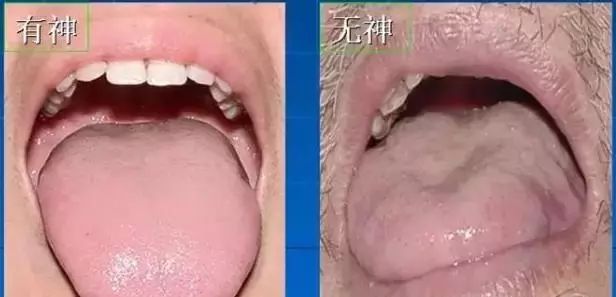
2. Tongue Color
Tongue color refers to the color of the tongue body, generally classified into six types: pale red, pale white, red, crimson, blue, and purple.
(1) Pale Red Tongue
【Tongue Characteristics】 The tongue body is pale red and moist, with a hint of red.
【Clinical Significance】 A pale red tongue is a sign of harmonious qi and blood, commonly seen in healthy individuals. In illness, it often indicates a mild condition.
【Mechanism Analysis】 A pale red tongue primarily reflects a physiological state of sufficient heart qi and blood, and vigorous stomach qi. The formation principle of tongue color is similar to that of skin color; red indicates blood, and bright luster indicates the vitality of stomach qi, as stated in the “Tongue Classification” which says: “A pale red tongue indicates a healthy state… red indicates heart qi, pale indicates stomach qi.”
In the early stages of an external pathogen, if the condition is mild and has not yet harmed qi, blood, or internal organs, the tongue color can remain normal and pale red; in internal injuries, it indicates a balance of yin and yang, and abundant qi and blood, often indicating a mild condition or a sign of recovery.
(2) Pale White Tongue
【Tongue Characteristics】 The tongue color is lighter than normal, with more white than red, referred to as a pale white tongue. If the tongue body is entirely white without any blood color, it is called a dry white tongue.
【Clinical Significance】 Indicates both qi and blood deficiency, and yang deficiency. A dry white tongue indicates damage to essence and loss of blood and qi.
【Mechanism Analysis】 Qi and blood deficiency leads to insufficient nourishment of the tongue, or yang qi deficiency results in weak blood circulation, causing the tongue color to be pale. Yang deficiency leads to internal cold, constricting the meridians, reducing blood flow to the tongue, which can also result in a pale tongue. The “Tongue Diagnosis” states that a pale white tongue is the “fundamental color of a cold tongue.”
If the tongue color is pale and the tongue body is thin, it indicates both qi and blood deficiency; if it is pale, moist, and the tongue body is plump and tender, it often indicates yang deficiency with water retention. Exhaustion of essence and blood, loss of blood and qi, and insufficient nourishment of the tongue lead to a dry and white tongue, indicating a serious condition.
Pale White Tongue▽
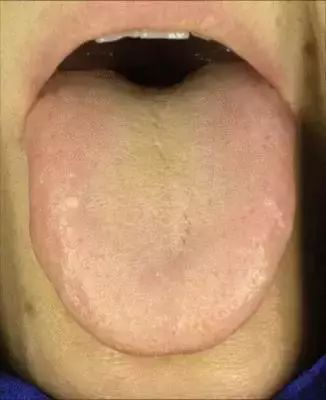
Dry White Tongue▽
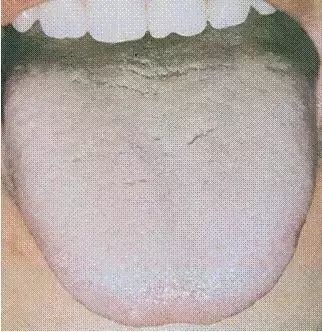
(3) Red Tongue
【Tongue Characteristics】 The tongue color is redder than normal, referred to as a red tongue.
【Clinical Significance】 Indicates excess heat or internal heat due to yin deficiency.
【Mechanism Analysis】 Blood becomes active with heat, causing blood vessels to dilate and blood flow to accelerate, leading to a bright red tongue; or due to yin deficiency and dehydration, leading to upward fire in the tongue. A slightly red tongue or only the tip and edges being red often indicates the initial stage of an external heat condition. A red and cracked tongue tip often indicates heart fire. A red tongue with little coating often indicates excess heat; a bright red tongue with little coating or cracks, or a small tongue often indicates deficiency heat. The “Tongue Diagnosis” states: “A bright red tongue with no coating, no moisture at the tongue base, and no liquid on the tongue surface indicates yin deficiency and fire.”
(4) Crimson Tongue
【Tongue Characteristics】 A tongue that is deeper red or slightly dark red is referred to as a crimson tongue.
【Clinical Significance】 Indicates excessive internal heat or vigorous yin deficiency fire.
【Mechanism Analysis】 A crimson tongue often develops from a red tongue. The causes include excessive evil heat, vigorous blood flow, and fullness of blood vessels leading to a red tongue; or heat entering the nutrient blood, damaging the yin, leading to concentrated blood and heat filling the tongue; or due to yin deficiency and dehydration, leading to upward fire in the tongue. Therefore, a crimson tongue indicates a more severe condition than a red tongue.
A crimson tongue with coating often indicates an external heat condition entering the nutrient blood or internal mixed diseases with excessive yang heat, indicating excess heat; the “Tongue Diagnosis” states: “Crimson is a deep red color. The heart governs the nutrient and blood, and a dry crimson tongue indicates that the evil has entered the nutrient blood.” A crimson tongue with little or no coating indicates damage to the stomach and kidney yin, often due to late-stage heat illness damaging yin liquid, or prolonged illness with vigorous yin deficiency fire, indicating deficiency heat.
Red Tongue▽
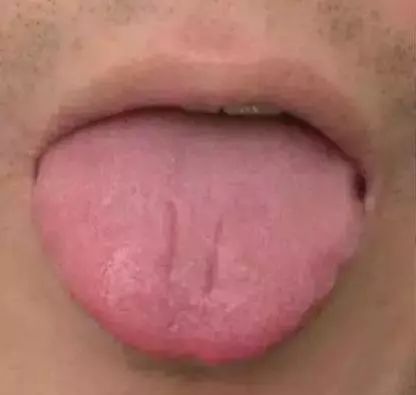
Red Tip Tongue▽
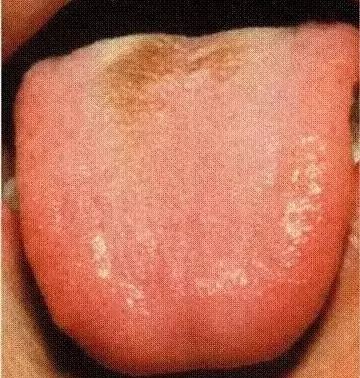
Red Tongue with Little Coating▽
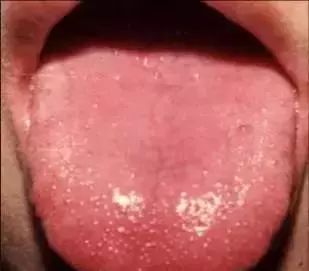
Crimson Tongue▽
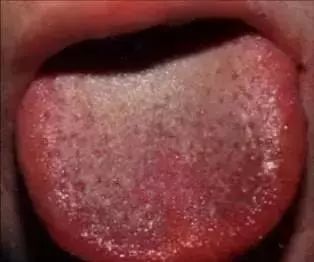
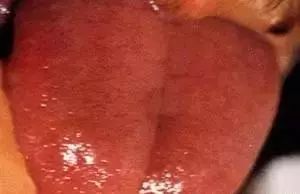
(5) Blue-Purple Tongue
【Tongue Characteristics】 The entire tongue appears uniformly blue or purple, or there are localized blue-purple spots, all referred to as blue-purple tongue. Blue-purple tongue can also present in various forms, such as a pale blue-purple tongue, a red tongue with blue-purple spots, or localized blue-purple spots on the tongue.
【Clinical Significance】 Indicates poor circulation of qi and blood.
【Mechanism Analysis】 A blue-purple tongue is caused by poor circulation of qi and blood. A uniformly blue-purple tongue indicates significant blood stasis, often due to systemic blood stasis; a tongue with purple spots indicates a lighter degree of stasis, often due to localized stasis or localized vascular damage.
The depth of the purple color is related to the nature of cold and heat. A pale purple or dark purple and moist tongue is often seen in conditions of yang deficiency and excessive yin. This is often due to internal cold, leading to stagnation of qi and blood. A blue tongue indicates severe cold and blood stasis, suggesting excessive internal cold and stagnation of yang qi. A dark purple or crimson tongue that is dry and lacks moisture, with little coating, often indicates heat conditions, suggesting excessive heat toxins penetrating the nutrient blood, damaging the yin, and causing poor circulation of qi and blood. A blue-purple tongue can also be seen in certain congenital heart diseases or drug and food poisoning.
Additionally, traumatic injuries can damage blood vessels, leading to bleeding and spots on the tongue, which may not show obvious abnormalities. A dark purple tongue or spots on the tongue often indicate internal blood stasis.
Pale Blue-Purple Tongue▽
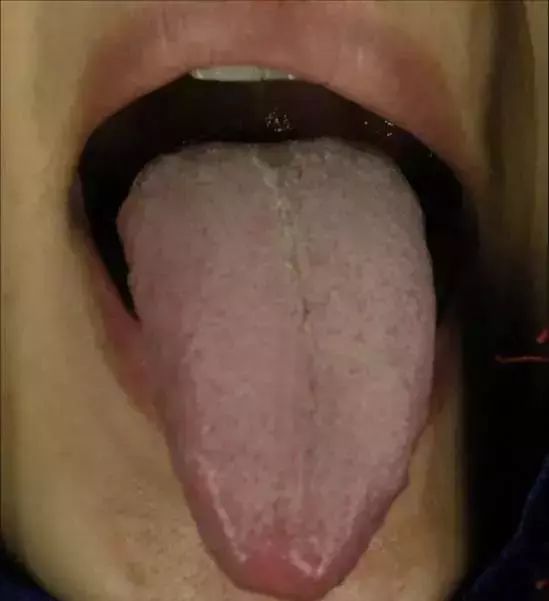
Blue-Purple Tongue▽
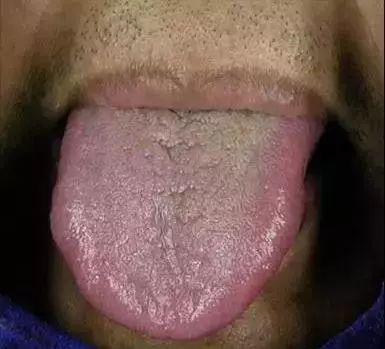
Crimson Purple Tongue▽
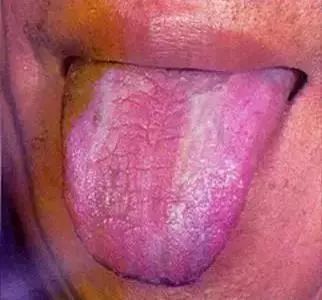
Stasis Spot Tongue▽
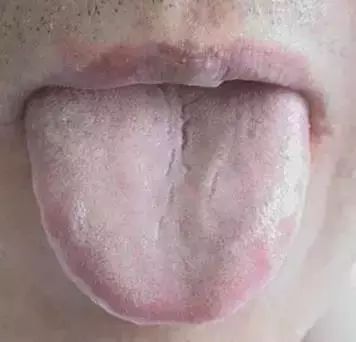
3. Tongue Shape
The shape and quality of the tongue include aspects such as age, thickness, points, cracks, and teeth marks.
(1) Old and Young
【Tongue Characteristics】 A tongue with rough or shriveled texture, firm and dark in color is referred to as an old tongue; a tongue with fine texture, plump and tender, and light in color is referred to as a young tongue.
【Clinical Significance】 An old tongue is often seen in excess conditions; a young tongue is often seen in deficiency conditions.
【Mechanism Analysis】 The quality of the tongue reflects a comprehensive manifestation of age. Old and young are indicators of the deficiency or excess of disease. The “Guide to Tongue Observation” states: “If the tongue quality is firm and dark, regardless of the coating color being white, yellow, gray, or black, the disease is often excess; if the tongue quality is plump and tender, regardless of the coating color being gray, black, yellow, or white, the disease is often deficiency.” When evil qi is excessive and fills the body, the righteous qi is not weakened, and the evil qi stagnates in the tongue, leading to an old tongue. Insufficient qi and blood fail to nourish the tongue; or if yang qi is deficient, blood circulation is weak, leading to a young tongue with a pale color. Insufficient essence and blood lead to a young tongue that is red with little coating.
Old Tongue▽
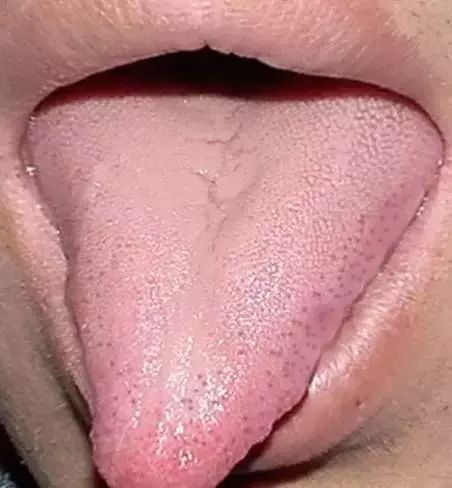
Young Tongue▽
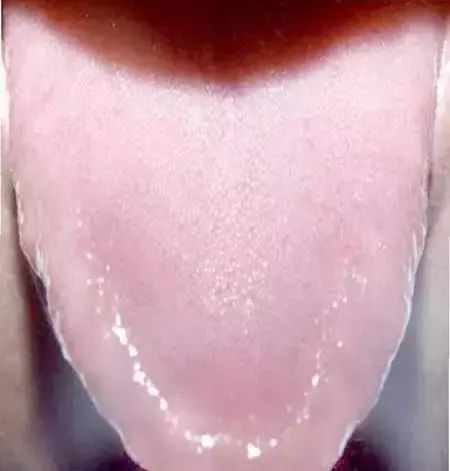
(2) Thick and Thin
【Tongue Characteristics】 A tongue that is larger and thicker than normal, filling the mouth, is referred to as a thick tongue. A tongue that is thin and small is referred to as a thin tongue.
【Clinical Significance】 A thick tongue often indicates internal water retention; a swollen tongue indicates excessive heart and spleen heat or external damp-heat. A thin tongue indicates insufficient qi and blood or excessive yin deficiency fire.
【Mechanism Analysis】 A thick tongue is often due to spleen and kidney yang deficiency, leading to abnormal qi transformation and obstruction of fluid distribution, resulting in internal water retention. A pale white tongue with a thick body often indicates qi deficiency or yang deficiency. A swollen tongue that is red often indicates internal heat. A swollen tongue that is crimson is often seen in cases of excessive heart and spleen heat, or heat toxins obstructing the tongue. Additionally, congenital tongue hemangioma patients may present with localized swelling of the tongue that is purple, indicating localized blood stasis, often without systemic diagnostic significance. A thin tongue is often due to insufficient qi, blood, and yin fluids, leading to a lack of nourishment. A thin tongue with a pale color is often seen in prolonged illness with qi and blood deficiency, where blood fails to nourish; a thin tongue that is crimson, dry, with little or no coating is often seen in cases of excessive yin deficiency fire, where yin fluids cannot nourish the tongue, leading to a thin tongue.
Thick Tongue▽
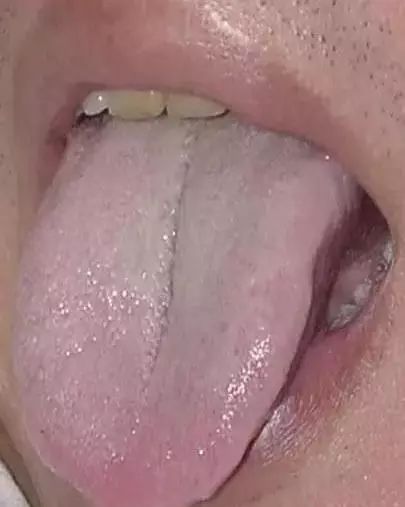
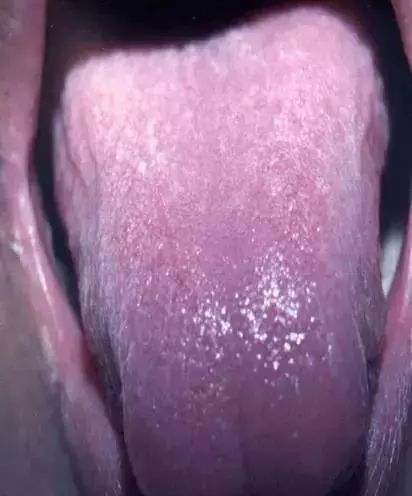
Thin Tongue▽
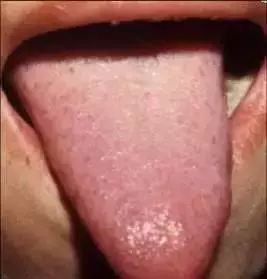
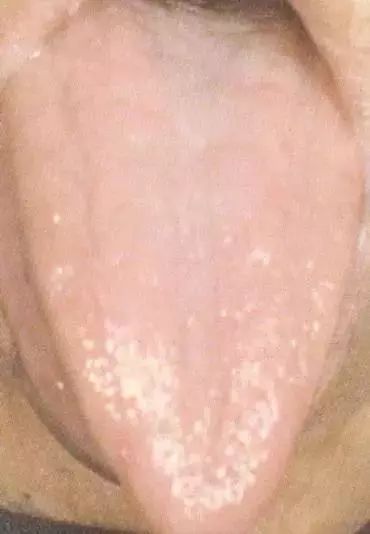
(3) Points and Spikes
【Tongue Characteristics】 Points refer to red or purple-red star-like protrusions on the tongue surface. Larger ones are called stars, and smaller ones are called points. Red points are referred to as red star tongue or red point tongue; white points are referred to as white star tongue. Spikes refer to enlarged, high protrusions of fungiform papillae that form sharp peaks, resembling thorns, referred to as thorn tongue. Points and spikes are similar and can occur together, hence collectively referred to as point-spike tongue. Point-spike tongue is most commonly seen at the tip of the tongue.
【Clinical Significance】 Indicates excessive yang heat in the organs or heat in the blood. Based on the location of the points and spikes, one can generally infer where the heat is located, such as points and spikes at the tip of the tongue often indicate excessive heart fire; points and spikes in the middle of the tongue often indicate excessive stomach and intestinal heat; points and spikes on both sides of the tongue often indicate liver and gallbladder heat, etc.
【Mechanism Analysis】 Points and spikes are pathological features of swollen or elevated fungiform papillae. Points indicate an increase in the size and number of papillae, with congestion and edema, even forming sharp peaks, resembling thorns, often due to internal heat stagnating in the tongue. The number of points and spikes correlates with the degree of heat; the more points and spikes, the more severe the heat. Observing the color of the points can estimate the circulation of qi and blood and the severity of the disease. For example, bright red points indicate excessive blood heat or excessive yin deficiency fire; crimson or purple points indicate heat and stagnation of qi and blood.
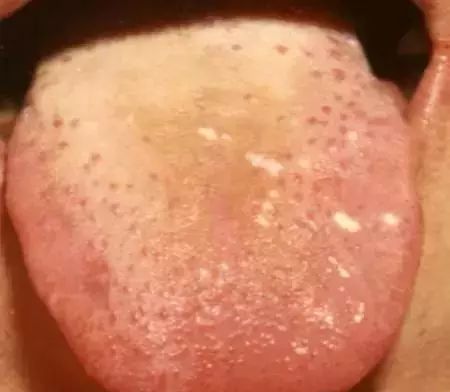
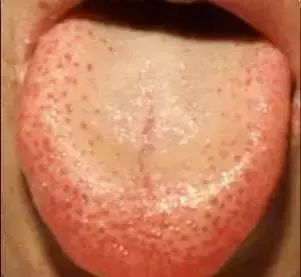
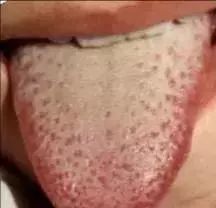
(4) Cracks
【Tongue Characteristics】 Various shapes of cracks or fissures appear on the tongue surface, varying in depth and number, collectively referred to as cracked tongue. Cracks may appear in shapes such as “人”, “|”, or “井”, and in severe cases may resemble brain folds, pebbles, or appear cut or shredded. If cracks have tongue coating, they are often congenital cracks.
【Clinical Significance】 Often seen in cases of essence and blood deficiency, or excessive yin deficiency fire, or spleen deficiency and qi weakness.
【Mechanism Analysis】 Cracked tongue is often due to insufficient nourishment of the tongue, atrophy of the tongue papillae, or tissue fissures. It is a manifestation of systemic malnutrition. A pale white tongue with cracks indicates blood deficiency, often due to blood deficiency failing to nourish the tongue, hence the “Guide to Tongue Observation” states: “Those with cracks indicate blood deficiency. Few cracks or shallow cracks indicate mild deficiency; many or deep cracks indicate severe deficiency.” A red or crimson tongue with cracks indicates excessive heat damaging fluids, or excessive yin deficiency fire, where yin fluids are depleted, leading to insufficient nourishment of the tongue. A uniformly crimson tongue, or one with horizontal or vertical cracks that are short, indicates severe yin deficiency and fluid depletion. A pale white, plump tongue with teeth marks and cracks indicates spleen deficiency and qi weakness.
In healthy individuals, about 0.5% have deep longitudinal or transverse grooves on the tongue surface, with cracks covered by coating, and no discomfort, indicating congenital tongue fissures, distinct from pathological cracks.
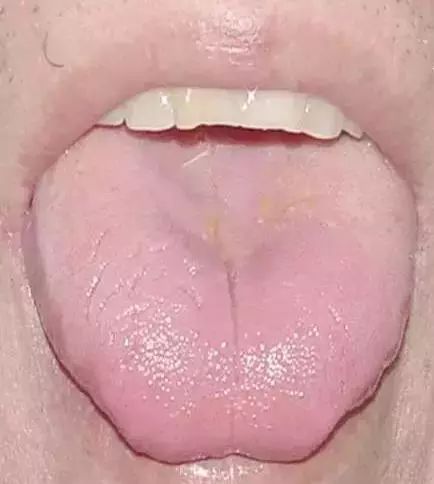
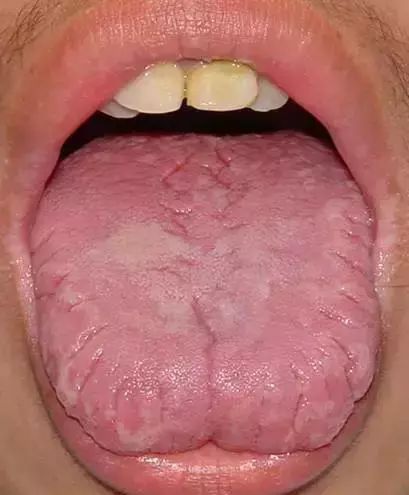
(5) Teeth Marks Tongue
【Tongue Characteristics】 The edges of the tongue show marks from teeth pressure, often accompanied by a plump tongue body.
【Clinical Significance】 Indicates spleen deficiency and internal water retention.
【Mechanism Analysis】 Teeth marks on the tongue edges are often due to pressure from a plump tongue body. Therefore, it is often seen with a thick tongue. A tongue that is not plump but has teeth marks is referred to as a delicate teeth marks tongue. A pale, plump tongue with teeth marks often indicates internal cold and dampness; a pale red tongue with teeth marks is often seen in cases of spleen deficiency and qi deficiency; if the tongue is red, swollen, and fills the mouth, with teeth marks, it indicates internal damp-heat and phlegm turbidity.
Additionally, congenital teeth marks tongue often presents with a non-plump, pale red, tender tongue with slight teeth marks; in pathological cases, it indicates a relatively mild condition, often seen in children and those with qi and blood deficiency.
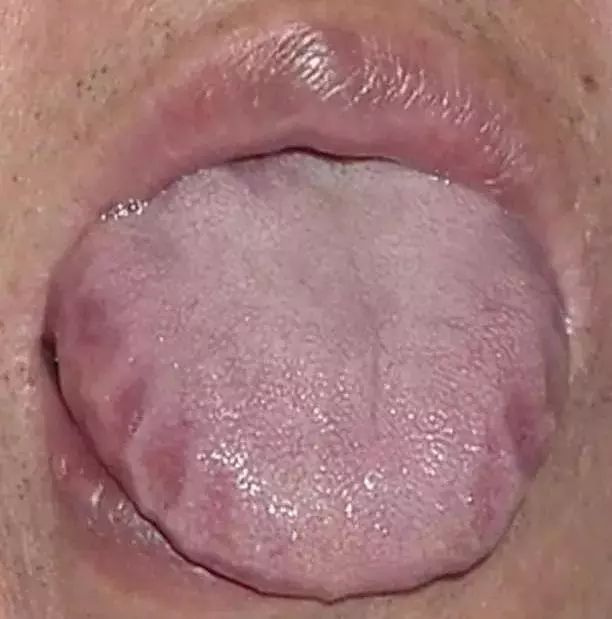
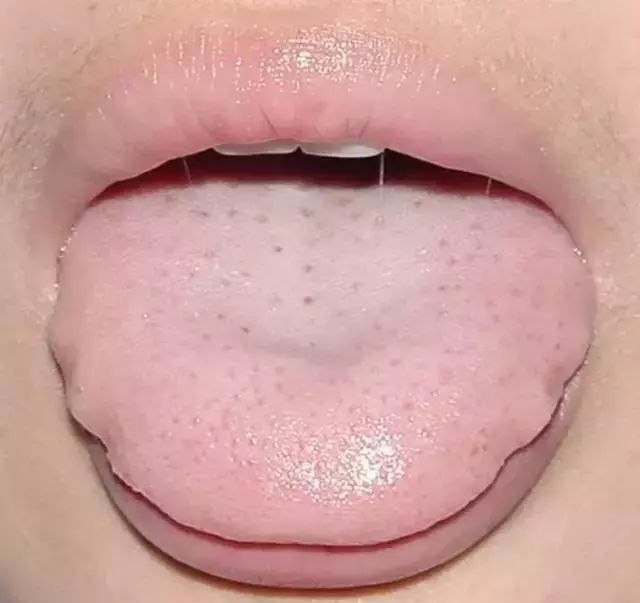
4. Tongue State
Tongue state refers to the dynamic of the tongue body. A tongue that moves flexibly and can extend and retract freely indicates a normal tongue state, suggesting abundant qi and blood, smooth meridians, and healthy organs. Common pathological tongue states include a flaccid tongue, stiff tongue, tremulous tongue, deviated tongue, protruding tongue, and shortened tongue.
(1) Flaccid Tongue
【Tongue Characteristics】 The tongue body is weak and lacks strength, unable to extend or retract freely.
【Clinical Significance】 Often indicates damage to yin or deficiency of both qi and blood.
【Mechanism Analysis】 A flaccid tongue is often due to qi and blood deficiency, or damage to yin fluids, leading to insufficient nourishment of the tongue muscles and vessels. A flaccid tongue that is red and has little coating is often seen in the later stages of external heat illnesses, where evil heat damages yin, or in prolonged internal injuries with excessive yin deficiency fire. A flaccid tongue that is pale and lacks luster often indicates deficiency of both qi and blood. This is often due to prolonged illness leading to qi and blood deficiency, where the tongue body fails to receive nourishment. In new illnesses, a dry and red tongue that becomes flaccid often indicates heat illness damaging fluids; a red, dry tongue that gradually becomes flaccid often indicates extreme deficiency of liver and kidney yin.
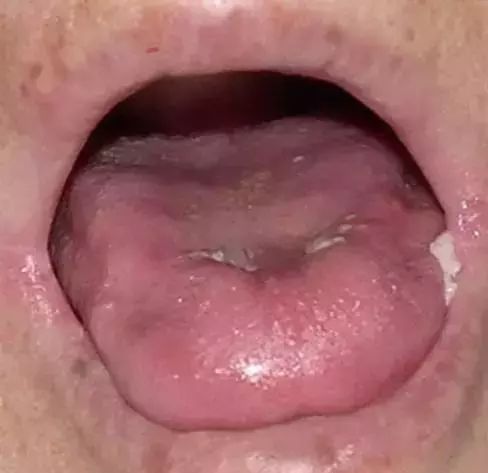
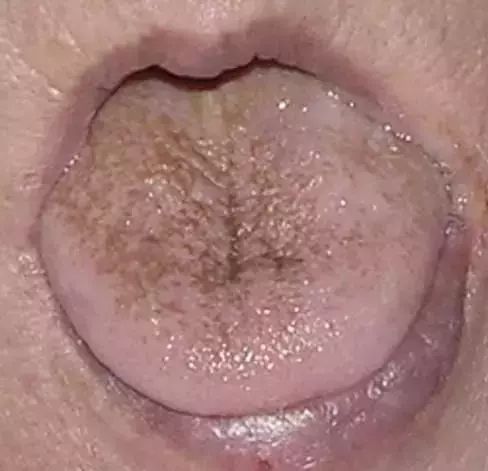
(2) Stiff Tongue
【Tongue Characteristics】 The tongue lacks flexibility, is difficult to bend, or is rigid and cannot rotate.
【Clinical Significance】 Often seen in cases of heat entering the pericardium, or high fever damaging fluids, or phlegm obstructing the meridians.
【Mechanism Analysis】 The “Essential Prescriptions of the Golden Chamber” states: “A stiff tongue that cannot speak indicates a disease in the organs.” This indicates that a stiff tongue is generally not a local issue but relates to internal organ diseases. A stiff tongue can be seen in external heat illnesses where heat enters the pericardium, disturbing the heart spirit, leading to a tongue that cannot function; or due to high fever damaging fluids, leading to insufficient nourishment of the tongue; or due to liver wind with phlegm, causing phlegm to obstruct the meridians, leading to a stiff tongue that cannot rotate. A stiff tongue that is red with little moisture is often seen in cases of excessive heat; a stiff tongue with thick and greasy coating is often seen in cases of phlegm obstructing the meridians; sudden stiffness of the tongue with slurred speech, accompanied by numbness of the limbs and dizziness, often indicates a precursor to stroke.
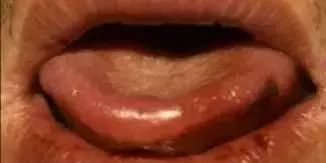
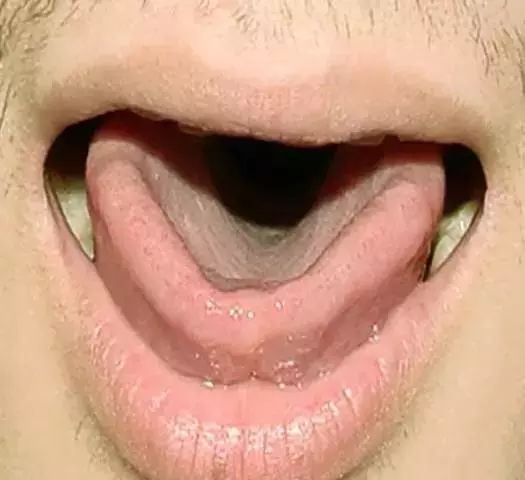
(3) Deviated Tongue
【Tongue Characteristics】 When extending the tongue, it deviates to one side, either left or right, referred to as a deviated tongue. Generally, the deviation is more pronounced in the front half of the tongue.
【Clinical Significance】 A deviated tongue is often seen in stroke, aphasia, or as a precursor to stroke.
【Mechanism Analysis】 A deviated tongue is often due to internal liver wind, phlegm, or blood stasis obstructing one side of the tongue meridians, leading to weakness in the tongue’s ability to extend, hence the affected side’s tongue muscles are relaxed while the healthy side’s tongue muscles function normally, causing the tongue to deviate towards the healthy side when extended.
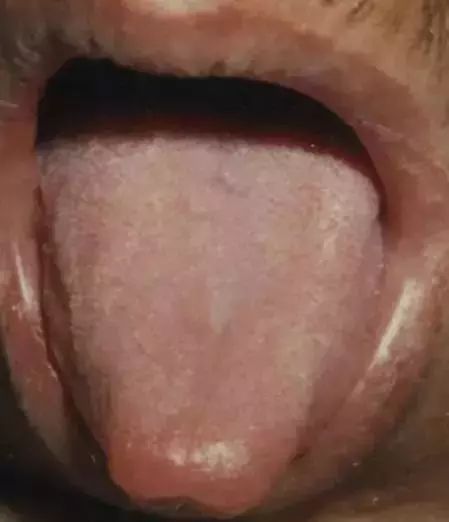
(4) Tremulous Tongue
【Tongue Characteristics】 The tongue trembles involuntarily, referred to as a tremulous tongue. In mild cases, it trembles only when extended; in severe cases, it trembles even when not extended.
【Clinical Significance】 Indicates internal liver wind.
【Mechanism Analysis】 A tremulous tongue is one manifestation of moving wind. When qi and blood are deficient, and yin fluids are depleted, the tongue fails to receive nourishment and moisture, leading to an inability to extend steadily, resulting in tremors; or due to extreme heat damaging fluids, which can also lead to a tremulous tongue. A pale white and tremulous tongue is often seen in cases of blood deficiency and moving wind; a crimson and tremulous tongue is often seen in cases of extreme heat and moving wind; a red tongue with little coating and tremors is often seen in cases of yin deficiency and moving wind. Additionally, a tremulous tongue can be seen in cases of alcohol toxicity.
(5) Protruding Tongue
【Tongue Characteristics】 The tongue extends outside the mouth and does not retract immediately, referred to as protruding tongue; if the tongue extends and retracts or repeatedly licks the lips, it is referred to as a moving tongue.
【Clinical Significance】 Often indicates heat in the heart and spleen.
【Mechanism Analysis】 Heart heat leads to moving wind, and spleen heat leads to fluid depletion, causing the tongue to protrude and move restlessly. Protruding tongue can be seen in cases of epidemic toxins attacking the heart, often indicating a critical condition; moving tongue often indicates a precursor to severe heat and moving wind. Protruding tongue can also be seen in children with developmental delays.
(6) Shortened Tongue
【Tongue Characteristics】 The tongue body is rolled up, short, and tight, unable to extend; in severe cases, the tongue does not reach the teeth. A shortened tongue often occurs alongside a flaccid tongue.
【Clinical Significance】 Often indicates a serious condition.
【Mechanism Analysis】 A shortened tongue that is pale white or blue-purple and moist often indicates cold constricting the meridians, or qi and blood deficiency leading to contraction of the tongue vessels or insufficient nourishment of the tongue body; a shortened tongue that is red and dry often indicates heat illness damaging fluids, or constriction of the meridians due to heat; a shortened tongue that is plump with slippery coating often indicates internal phlegm turbidity and wind-phlegm obstructing the meridians. In summary, a shortened tongue indicates a serious condition.
Additionally, congenital short frenulum can also affect tongue extension, referred to as a tied tongue, which has no diagnostic significance.
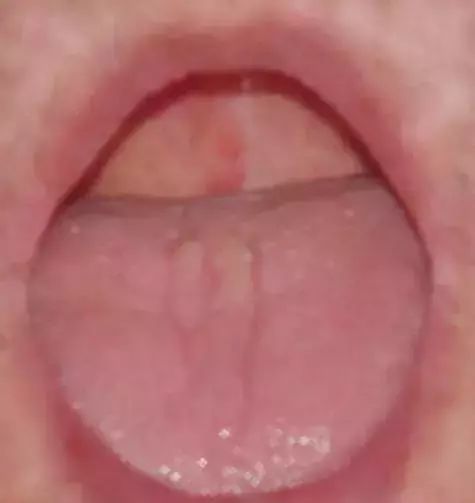
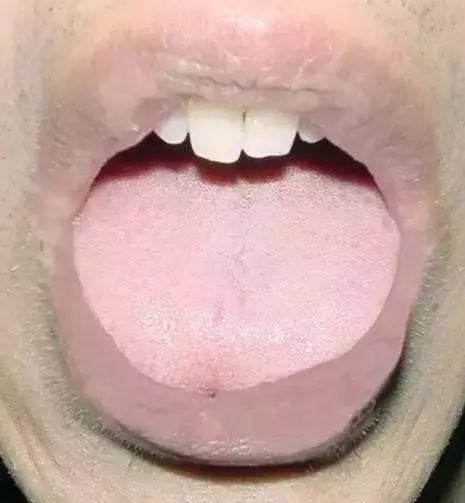
5. Sublingual Vessels
In normal individuals, there are two longitudinal major vessels on each side of the tongue frenulum, referred to as sublingual vessels. Also known as “stasis vessels,” the mucosa under the tongue forms a prominent fold connected to the floor of the mouth, called the tongue frenulum. On both sides of the frenulum, shallow blue veins can be seen through the mucosa, referred to as sublingual vessels or tongue veins in TCM. In normal individuals, the sublingual vessels are visible, with a diameter not exceeding 2.7 cm and a length not exceeding three-fifths of the line connecting the tip of the tongue to the end of the frenulum. The color is dark red. The vessels should not be engorged, constricted, twisted, or hyperplastic, and should be arranged in an orderly manner. The vast majority are single branches, with very few double branches appearing.
Observing the sublingual vessels mainly involves examining their length, shape, color, thickness, and the small blood vessels around them.
The method for observing the sublingual vessels is: have the patient open their mouth, lift the tongue towards the palate, lightly touching the palate with the tip of the tongue without excessive force, allowing the tongue to relax naturally, fully exposing the sublingual vessels. First, observe the length, thickness, and color of the major vessels on both sides of the frenulum, noting any engorgement, twisting, or other abnormal changes, then observe the color and shape of the surrounding small vessels for any abnormalities.
Abnormalities in the sublingual vessels and their clinical significance: Short and thin sublingual vessels, with surrounding small vessels not prominent, and a pale tongue color often indicate qi and blood deficiency, with insufficient vessel filling.
Thick and engorged sublingual vessels, or those appearing blue-purple, crimson, or dark purple, or small surrounding vessels appearing as a dark red or purple network, or engorged sublingual vessels resembling purple beads of varying sizes, all indicate blood stasis. The causes may include qi stagnation, cold constriction, heat depression, phlegm dampness, qi deficiency, or yang deficiency.
It is necessary to analyze in conjunction with other symptoms.
Changes in the sublingual vessels may sometimes precede changes in tongue color, thus the sublingual vessels are an important basis for analyzing the circulation of qi and blood.
The diagnosis of sublingual vessels refers to the examination of the color, shape, and fullness of the sublingual vessels to assist in disease judgment. Normal sublingual vessels are visible under the tongue, with a dark red color, soft shape, and no twisting or constriction, not exceeding one-third of the tongue. Therefore, when examining for blood stasis, one should first observe the sublingual vessels.
Pathological changes in the sublingual vessels mainly manifest in color and shape. If the sublingual vessels are blue-purple, with a long or engorged shape, it indicates qi stagnation and blood stasis, or phlegm and blood congealing; if the color is pale purple, with a coarse or engorged shape, it indicates cold evil stagnation or qi deficiency and blood stasis; if the color is purple-red, with an engorged shape, it indicates heat obstructing blood stasis; if the color is pale red or light blue, with a small shape, it indicates weakness of the righteous qi. Therefore, changes in the sublingual vessels mainly indicate the presence of blood stasis, confirming whether the stasis is due to qi stagnation, cold congealing, qi deficiency, or heat obstruction based on the colors blue-purple, pale purple, and purple-red.
The “stasis vessels” are classified into four degrees: 0 degrees, I degree, II degree, and III degree.
0 degrees indicates that the two sublingual veins are visible, with a main diameter below 2.6 mm, a length not exceeding the frenulum’s endpoint, and the entire sublingual vein is neither twisted nor engorged;
I degree (++) indicates that the main branch is full, with a diameter not exceeding 2.6 mm, a length not exceeding half the distance from the frenulum’s endpoint to the tip of the tongue, with slight bending;
II degree (+++) indicates that the main branch is full, with a diameter exceeding 2.6 mm, a length exceeding three-fifths of the distance from the frenulum’s endpoint to the tip of the tongue, with slight bending; II degree (+++) indicates that there is obstruction of qi and blood in the body.
III degree (++++), indicates that the main branch is full, significantly engorged, with a diameter exceeding 2.6 mm, a length exceeding three-fifths of the distance from the frenulum’s endpoint to the tip of the tongue, or reaching the tip of the tongue, with coarse branch-like extensions or bead-like nodules. III degree (++++) indicates the presence of early tumors in the body.
Normal Sublingual Vessels▽
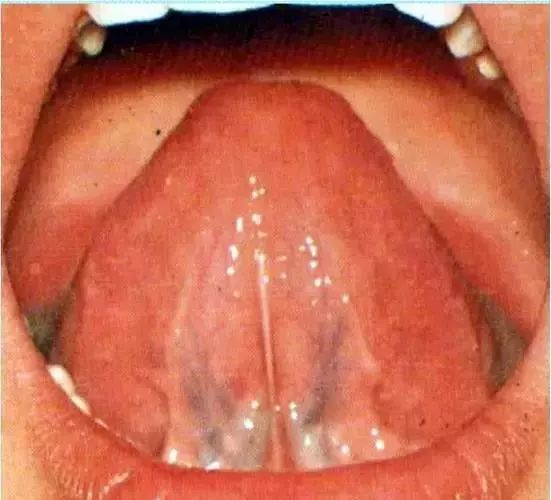
Sublingual Vessels Short and Thin▽
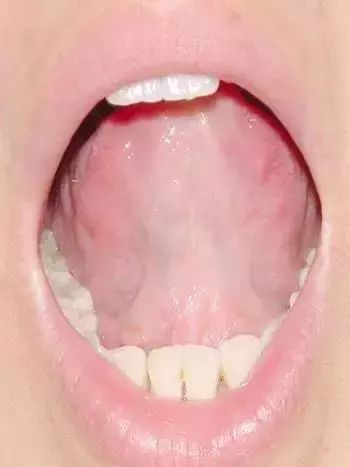
Sublingual Vessels Thick and Engorged▽
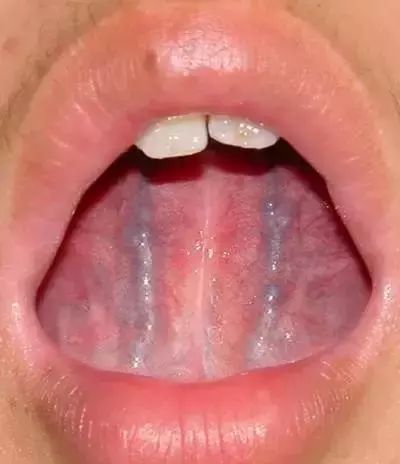
Sublingual Vessels Engorged▽
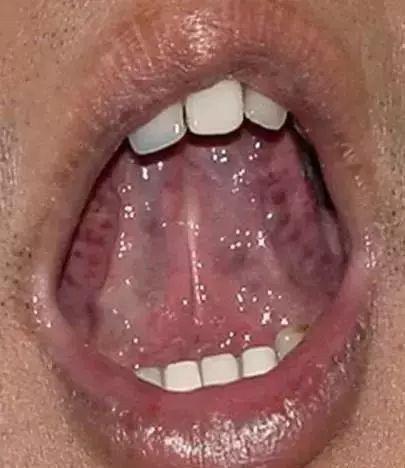
Observing Tongue Coating
(Including normal coating, thin coating, thick coating, greasy coating, rotten coating, moldy coating, moist coating, slippery coating, dry coating, rough coating, peeled coating, similar peeled coating, geographic tongue, mirror tongue)
1. Normal Coating
• The color of normal coating is thin white, evenly distributed, with moderate thickness and moisture, while the tongue color appears pale red and fresh.
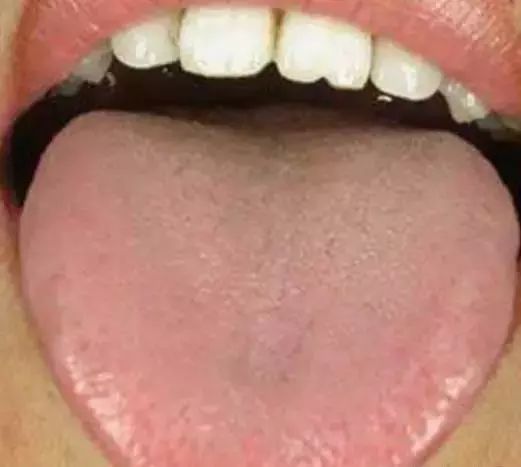
2. Thin Coating
• Thin coating allows the tongue body to be faintly visible through the coating, also known as “seeing the bottom coating.” Seen in healthy individuals or in the early stages of external conditions.
• Thin coating is considered normal tongue coating, thin and evenly distributed on the tongue surface, slightly thicker in the center. Thin coating is originally formed due to the upward steaming of stomach qi.
• In illness, thin coating indicates the initial stage of disease, with the pathogen still on the surface, indicating a mild condition.
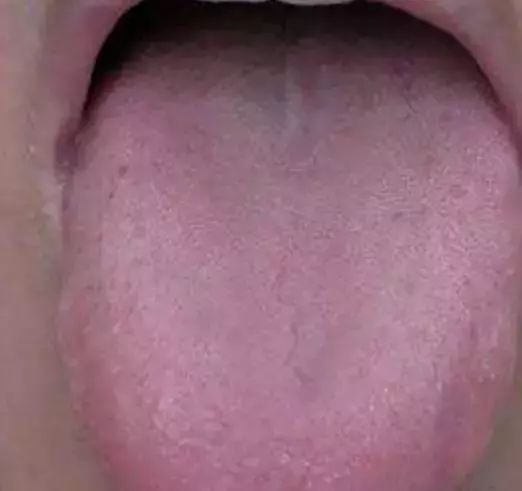
3. Thick Coating
• Thick coating does not allow the tongue body to be seen, also known as “not seeing the bottom coating.” Seen in internal conditions.
• Thick coating often indicates a stronger pathogen, having moved from the surface to the interior.
• Or gastrointestinal dysfunction leading to indigestion.
• Or internal phlegm dampness, with the coating gradually thickening as the disease progresses.
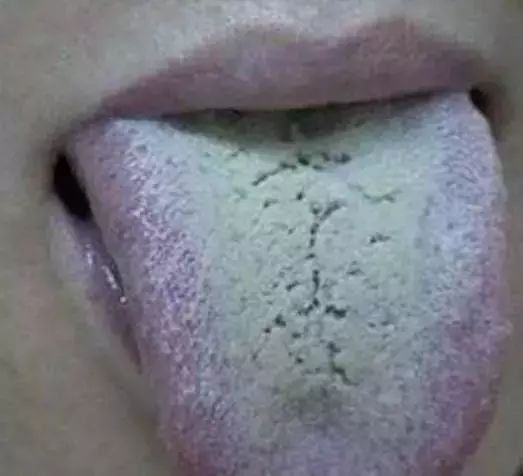
4. Greasy Coating
• Greasy coating is thicker in the center and root of the tongue, while the edges and tip are slightly thinner, with a layer of mucous covering the tongue, resembling an oily appearance, often obscuring the tongue body.
• Greasy coating is often formed due to undigested water and dampness, commonly seen in damp turbidity, phlegm, food accumulation, and damp-heat conditions.
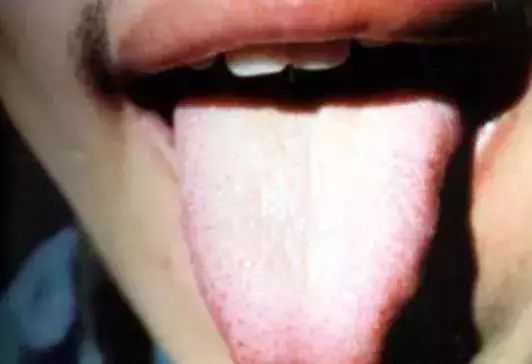
5. Rotten Coating
• Rotten coating is thick with coarse and loose particles, resembling a pile of tofu dregs on the tongue surface, easily scraped off.
• Often caused by evil heat steaming the stomach, leading to putrid turbidity rising.
• Rotten coating indicates food accumulation in the stomach, internal phlegm turbidity, and weak stomach qi.
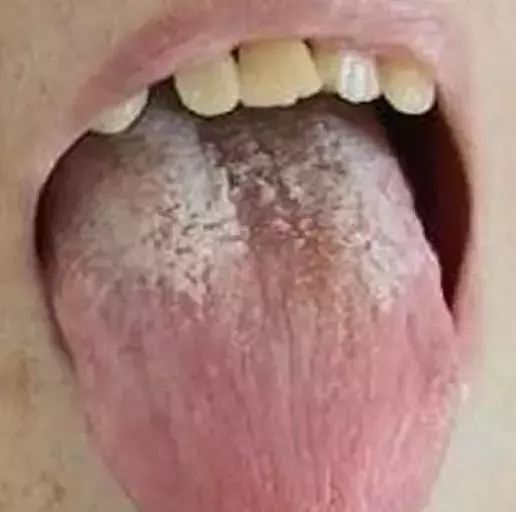
6. Moldy Coating
• Indicates deficiency of both qi and yin, with damp-heat and turbid evil rampant.
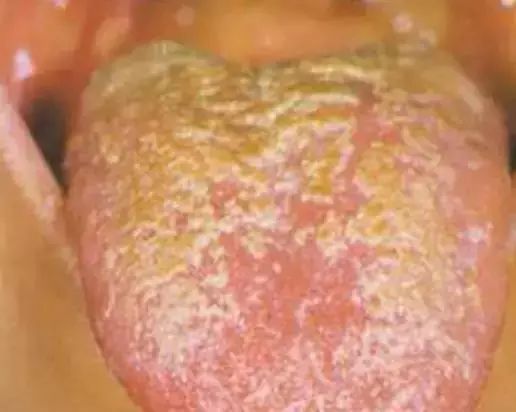
7. Moist Coating
• The tongue coating is moderately moist, neither slippery nor dry.
• Seen in normal tongue coating or during the disease process when fluids have not been damaged.
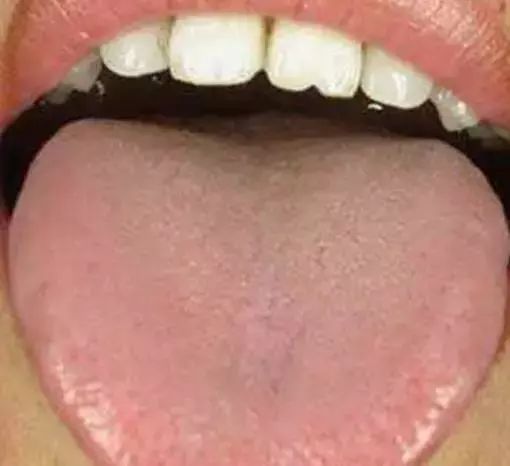
8. Slippery Coating
• The tongue surface has excessive moisture, dripping when extended, and feels wet and slippery.
• Indicates cold.
• Indicates dampness.
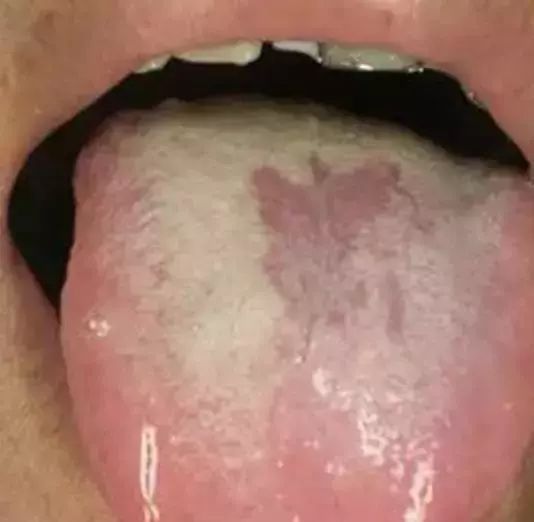
9. Dry Coating
• The tongue coating is dry, lacking moisture, and may even crack.
• Indicates fluid depletion.
• Indicates internal obstruction of dampness, preventing fluids from ascending.
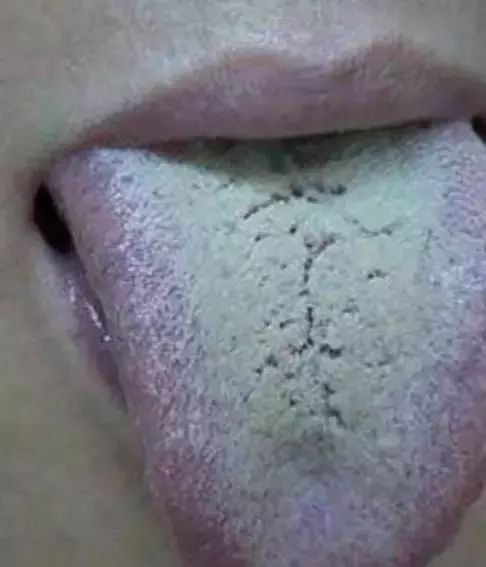
10. Rough Coating
• The coating is coarse in texture.
• Dry and coarse indicates severe heat damaging fluids.
• Coarse but not dry indicates turbid evil occupying the middle burner.
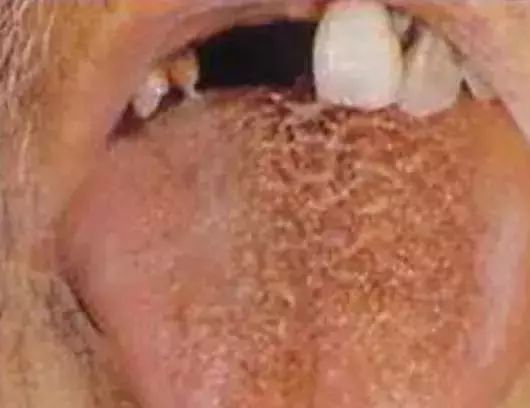
11. Peeled Coating
• Refers to partial or complete loss of tongue coating, with smooth areas on the tongue surface.
• The degree of peeling is related to the severity of the disease.
• The areas of peeling may sometimes correspond to the organ regions on the tongue surface.
• A red tongue with peeled coating indicates yin deficiency.
• A pale tongue with peeled coating indicates blood deficiency or deficiency of both qi and blood.
• Congenital peeled coating is often seen in the central groove of the tongue, appearing diamond-shaped.
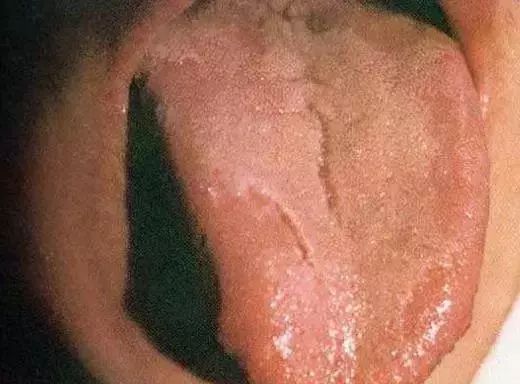
12. Similar Peeled Coating
• Refers to areas of peeled coating where the tongue surface is not smooth, with new granular or papillary structures visible.
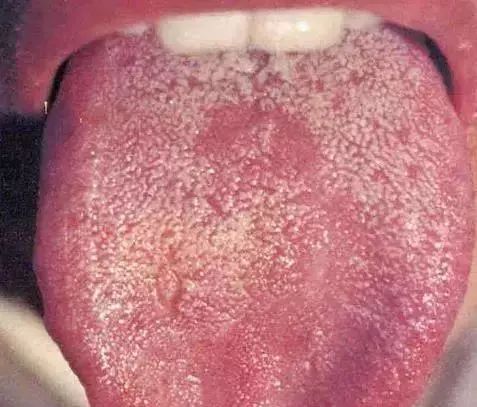
13. Flower Peeled Coating
• Flower peeled coating, greasy and slippery, indicates that the righteous qi is weak, and damp turbidity has not been transformed.
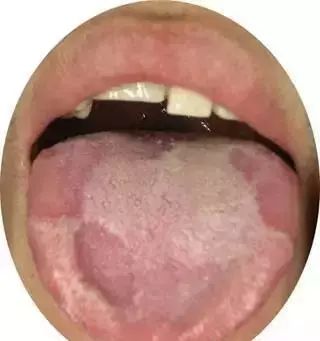
14. Geographic Tongue
• Refers to large areas of peeled coating on the tongue, with raised edges, clearly defined boundaries, and areas of peeling that move over time.
• Indicates deficiency of stomach qi.
• Indicates depletion of stomach yin.
• Or deficiency of both qi and blood.
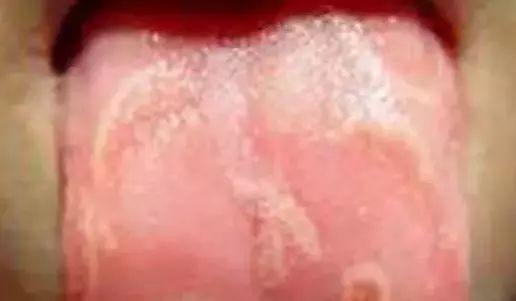
15. Mirror Tongue
• Refers to a tongue surface without coating, smooth like a mirror.
• A red tongue indicates dry stomach yin.
• Often seen in conditions of severe damage to yin fluids.
• If the tongue is smooth and red, it indicates excessive heat damaging yin.
• If the tongue is smooth and pale, it indicates damage to both qi and yin.
• If the tongue is smooth and withered, it indicates critical illness due to depletion of original qi.
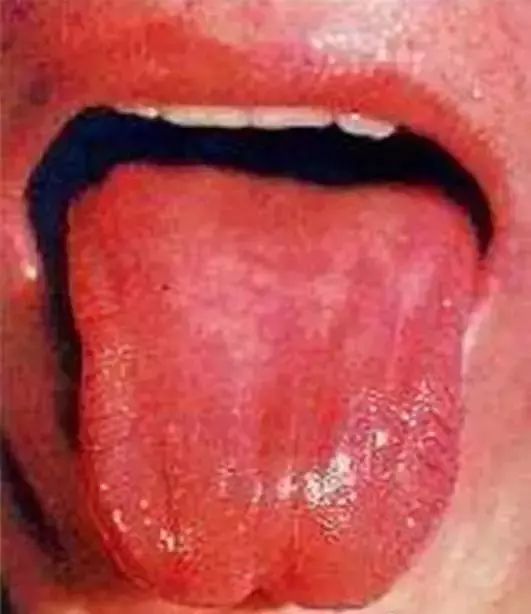
(2) Coating Color (Including White Coating, Yellow Coating, Gray-Black Coating)
1. White Coating
• Thin white and moist coating indicates a normal tongue; initial stage of external conditions; mild internal conditions; or yang deficiency with internal cold.
• Thin white and dry coating indicates wind-heat external conditions.
• Thin white and slippery coating indicates external cold dampness or internal water retention.
• Thick white and greasy coating indicates damp turbidity, phlegm, or food accumulation.
• Thick white and greasy coating that is dry indicates obstruction of dampness, preventing fluids from ascending.
• White coating resembling accumulated powder, feeling not dry, indicates a combination of warm disease with turbid dampness and heat toxins.
• White coating that is dry and cracked, feeling rough, indicates dryness-heat damaging fluids.
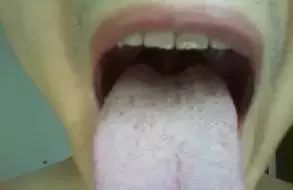
2. Yellow Coating
• Thin yellow coating indicates wind-heat external conditions or wind-cold transforming into heat entering the interior.
• Yellow and white mixed coating indicates a stage of transformation from external conditions to internal conditions, or a combination of both.
• Yellow greasy coating indicates damp-heat accumulation, phlegm transforming into heat, or food accumulation leading to heat corruption.
• Yellow rough coating, yellow petal coating, or scorched yellow coating all indicate evil heat damaging fluids and obstructing the interior.
• Yellow slippery coating indicates a body with yang deficiency and cold dampness, where phlegm accumulates and transforms into heat; a body with yang deficiency that is affected by damp-heat.
3. Gray-Black Coating
• Gray coating and black coating are similar, with gray coating being a lighter black coating.
• Indicates severe internal heat or internal cold conditions.
• The moisture and dryness of the coating are key to determining the cold-heat properties of gray-black coating.
• Gray-black coating with a moist tongue and pale white, plump tongue indicates yang deficiency with cold dampness or phlegm retention.
• Yellow greasy gray-black coating indicates damp-heat accumulation that has not transformed over time.
• Charred black and dry coating, with a tongue that is dry and cracked, indicates extreme heat damaging fluids.
• Moldy sauce coating (yellow-red mixed with black) indicates accumulated food and dampness transforming into heat, leading to blood stasis and qi stagnation.
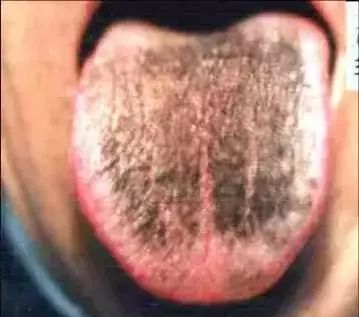

— END —

Ni Haixia Acupuncture Learning Video Collection
Ni Haixia Golden Chamber Learning Video Collection
Ni Haixia Huangdi Neijing Learning Video Collection
Ni Haixia Shanghan Lun Learning Video Collection
Ni Haixia Materia Medica Learning Video and Tianji Learning Video Collection

Divine Doctor Treatment:
Dr. Xu’s Medical Cases
Dr. Xu’s Remote Diagnosis
Dr. Xu’s Introduction
Dr. Xu’s Recommendations
Professional Hand Diagnosis
Add Friends↓↓↓↓, Diagnosis, Treatment, Learn TCM:


